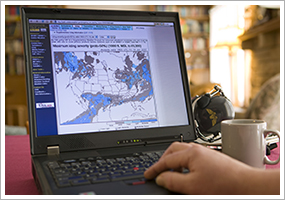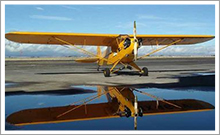Sept. 17, 2010 issue of 'AOPA ePilot - Flight Training Edition' newsletter
| ||||
| | FT News | INSIDE AOPA | TRAINING PRODUCTS | FINAL EXAM | |||
TRAINING TIPsDestination weather
In such cases the pilot must construct a weather picture by gathering as many surface weather reports as possible from surrounding points, as recommended in Chapter 12 of the Pilot’s Handbook of Aeronautical Knowledge : “The information gathered for the surface observation may be from a person, an automated station, or an automated station that is updated or enhanced by a weather observer. In any form, the surface observation provides valuable information about individual airports around the country. Although the reports cover only a small radius, the pilot can generate a good picture of the weather over a wide area when many reporting stations are looked at together.” AOPA Airports, the online directory, does that for you when you look up an airport, as this entry for the AWOS-3-equipped Frederick, Md., airport illustrates with the section labeled “METARS from nearby stations.” Some destinations may present greater challenges when you need information about their weather. The Greenville, Maine, airport is situated in locally mountainous terrain and is equipped with limited reporting, according to this note “AWOS–A” in its listing in the digital airport/facility directory. (AWOS-A only provides the altimeter setting.) When en route, consider requesting an informal weather update from the FBO or a pilot on the common traffic advisory frequency. Review Chapter 7 of the Aeronautical Information Manual, which lists the various types of automated weather systems, their capabilities, and their limits. Note that there may be a qualitative difference between automated observations and those made by a human observer. “Human observers take in the entire sky to make judgments about cloud heights, ceilings, and sky cover. They can also identify potentially dangerous cloud types,” wrote Thomas A. Horne in the September 2000 Flight Training article “ The Weather Never Sleeps: ASOS Insights.” However, “To ASOS, a cloud base is a cloud base, whether it's caused by a solitary fair-weather cumulus or a raging cumulonimbus.” Finally, while summer weather may be a memory for many pilots, it lingers in many parts of the country. If you need a brush-up, try the AOPA Air Safety Foundation’s Summer Weather Safety Spotlight. YOUR PARTNER IN TRAININGAs a student pilot, you are a member of your airport's community, which includes the aviation businesses and pilots who base their personal aircraft there. You are obligated to know and follow any noise abatement policies that your airport utilizes. Where do you find these? Your first stop is the airport/facility directory, which lists noise abatement policies and procedures under "airport remarks." (You'll also find them in the printed and online versions of AOPA Airports and on the back of Jeppesen instrument approach plates.) Noise ordinances vary, so pilots who plan to fly into an airport with a noise abatement program should call the airport in advance to find out the details of its particular policy. For more information, see the July 2003 issue of Flight Training.
Did you know that student pilots who join AOPA are three times more likely to complete their flight training? Membership includes unlimited access to aviation information by phone (800/USA-AOPA, weekdays from 8:30 a.m. to 6 p.m. Eastern time) or from AOPA Flight Training Online or AOPA Online. If you're not already a member, join today and get the pilot's edge. Login information is available online. FLIGHT TRAINING NEWSFAA proposes fatigue-fighting rulesConcerned about fatigue as a risk factor in airline accidents attributed to pilot error, the FAA is proposing to amend its existing flight, duty, and rest regulations that apply to certificate holders and their flight crewmembers. The changes would affect pilots flying for the airlines, but general aviation pilots should bear in mind that all pilots are susceptible to fatigue and the diminished decision-making ability that flying in a fatigued condition can cause. Read more >> New mayor, new Meigs?Meigs Field on the Chicago lakefront was once a popular airport and many a student pilot’s dream location to land. Those dreams were dashed in 2003 when Mayor Richard Daley ordered the airport closed and converted it into a park. Flash forward to 2010, and Daley has signaled he won’t run for re-election. Could the end of his era mean a rebirth for Meigs? Read more >> Pilots’ group to fly Gulf Coast animal rescueThe volunteer group Pilots N Paws will fly an airlift of abandoned animals from the Gulf Coast area this weekend, taking them to designated points around the country. As many as 30 general aviation aircraft will land in New Orleans and fly the animals to Lakeland, Fla.; Washington, D.C.; and Caldwell, N.J. Read more >> Inside AOPAGet a pirep, give a pirepAlso known as “pilot reports,” pireps are a great source of real-time, in-flight weather to fill in the gaps between forecasts and ground-based weather observations. Learn how to get, use, and give pireps with the AOPA Air Safety Foundation’s SkySpotter: Pireps Made Easy interactive online course. You will learn about the reporting sequence, how to estimate cloud heights and visibility, and how to report turbulence and icing. Don’t worry about memorizing everything—download the handy pirep form before your next flight. Ready to copy? Take the course >> You’re not alone up thereSometimes, things just don’t go as planned. That “obvious” visual checkpoint on your chart? Totally invisible. Or the clear-and-a-million weather you expected on the last leg of your cross-country? More like pea soup. Learning to cope with the unexpected is part of learning to fly—but sometimes even the most experienced pilots need to ask for help. But how do you make that decision? And who do you call? The AOPA Air Safety Foundation’s Say Intentions Safety Advisor has the answers. Hertz offers special savings on car rentalsAs an AOPA member, renting your next vehicle from Hertz not only gives you up to 25 percent off and free enrollment in the #1 Club Gold Program, but you’ll also receive special bonus savings. Save up to $35 off a weekly or weekend rental when you include PC#148396 in your reservation of an economy through full-size car. The offer is valid on rentals booked now through Nov. 14 for vehicle pickup through Dec. 17. A portion of all revenue generated will be returned to AOPA and reinvested to support the association’s daily efforts to maintain the freedom, safety, and affordability of general aviation. Reserve your car today. Deck the halls with AOPAAOPA is launching a series of limited-edition holiday ornaments. For the first year’s ornament, the 1939 Electra Jr. has been selected. An aircraft similar to what Amelia Earhart flew on her infamous last journey, the Electra Jr. was a popular aircraft in 1939, the same year in which AOPA was founded. Measuring 2.5 inches high by 3 inches wide, the AOPA Holiday Ornament is made of stamped metal and has a three-dimensional effect. As with all AOPA merchandise, the proceeds from the sale of the holiday ornament go toward protecting and championing general aviation. Visit the AOPA Store online to purchase yours today. TRAINING PRODUCTSYour solo shirttail, framed for displayHas the shirttail from your first solo been sitting in a box, at risk of becoming a dust rag? Sporty’s will mount your shirttail in a museum-quality custom frame so that you can enjoy it always. Framing costs $125. See the website for details.
Note: Products listed have not been evaluated by ePilot editors unless otherwise noted. AOPA assumes no responsibility for products or services listed or for claims or actions by manufacturers or vendors. FINAL EXAMQuestion: What should a pilot say on initial contact with air traffic control?
Answer: The Aeronautical Information Manual (AIM) is a great resource for radio communications phraseology and techniques. Chapter 4, Section 2 offers several pages on the topic. The recommendation for initial contact is to state the name of the facility being called followed by the aircraft‘s complete N-number or call sign. You may follow that with a short request. If you make a long request on first contact, a controller who is working several aircraft will probably ask you to repeat it. It is best to make your request once ATC has responded to your initial contact. Here are a couple of examples from the AIM: “New York Radio, Mooney Three One Echo” or “Miami Center, Baron Five Six Three Hotel, request VFR traffic advisories.” For more on radio communication, take the AOPA Air Safety Foundation‘s interactive course, Say It Right: Mastering Radio Communication .
Got a question for our technical services staff? E-mail [email protected] or call the Pilot Information Center, 800/872-2672. Don’t forget the online archive of “Final Exam” questions and answers, searchable by keyword or topic. what’s new onlineHoles in your trainingUnless you’re an elephant, you’re bound to forget some things during the course of your flying. How do you deal with these holes in your knowledge? In the latest Flight Training blog, Associate Editor Jill W. Tallman reflects on a recent trip that revealed an area in need of improvement. Picture Perfect
AVIATION EVENTS & WEATHER To include an event or to search all events in the calendar, visit AOPA Online. For airport details, including FBO fuel prices, see AOPA Airports. Flight Instructor Refresher ClinicsThe next AOPA Air Safety Foundation Flight Instructor Refresher Clinics are scheduled in Phoenix, Ariz., Sept. 25 and 26; Windsor, Conn., and Columbia, S.C., Oct. 2 and 3; Wichita, Kan., and Nashville, Tenn., Oct. 9 and 10; Indianapolis, Ind., and Corpus Christi, Texas, Oct. 16 and 17. For a complete schedule, see AOPA Online.
Can’t make it in person? Sign up for the CFI Refresher Online. AOPA Air Safety Foundation Safety SeminarsAOPA Air Safety Foundation Safety Seminars are scheduled in Rochester, Minn., and Reno, Nev., Sept. 20; Sacramento, Calif., and Cedar Rapids, Iowa, Sept. 21; San Jose, Calif., and Bellevue, Neb., Sept. 22; Olathe, Kan., Sept. 23; Mesa, Ariz., St. Louis, Mo., Pittsburgh, Pa., and Fort Worth, Texas, Sept. 27; Tucson, Ariz., Springfield, Mo., Summerdale, Pa., and Houston, Texas, Sept. 28; Albuquerque, N.M., Allentown, Pa., and San Antonio, Texas, Sept. 29; King of Prussia, Pa., and Austin, Texas, Sept. 30; Bolingbrook, Ill., Oct. 4; Northbrook, Ill., Oct. 5; Rockford, Ill., Oct. 6. Topics vary—for details and a complete schedule, see AOPA Online. | Got news? Contact ePilot. Having difficulty using this service? Visit the ePilot Frequently Asked Questions now at AOPA Online or write to [email protected]. |
| Editorial Team: ePilot Flight Training Editor : Jill W. Tallman | ePilot Editor: Sarah Brown | Contributor: Alton Marsh |

 What kind of weather reporting is available at the airport you’ll be flying to on your next cross-country? An ever-growing list of airports is now equipped with weather reporting capabilities. But some destinations still lack weather reporting systems, or only have systems with limited capabilities. That leaves a pilot dependent on indirect methods of knowing what’s up.
What kind of weather reporting is available at the airport you’ll be flying to on your next cross-country? An ever-growing list of airports is now equipped with weather reporting capabilities. But some destinations still lack weather reporting systems, or only have systems with limited capabilities. That leaves a pilot dependent on indirect methods of knowing what’s up.


